Prescribed Fixed-Time Adaptive Neural Control for Manipulators with Uncertain Dynamics and Actuator Failures
Abstract
1. Introduction
- An actuation scheme is constructed for redundant control inputs so that the possible interaction problem in the control gain matrix can be well-circumvented, and then an adaptive compensation mechanism is raised to accommodate the actuator failures, which are unknown in time, pattern, and values.
- Based on the developed adaptive actuator failure compensation strategy, we further propose a PPB-based adaptive neural control algorithm to establish the conditional inequality of fixed-time stability, so that the response plot of tracking error can be kept within some prescribed bounds, and converges to a residual around zero in a bounded settling time (which can be independent of the initial system states).
- For our raised scheme, an optimization strategy is adopted in the design of adaptive laws for handling the unknown weight matrix of neural networks, based on which it is well achieved that the number of adaptive parameters does not increase with the number of neurons. In this sense, the proposed scheme is computationally attractive.
2. Problem Statement and Preliminaries
2.1. Problem Formulation
2.2. Preliminaries
3. Control Design
| Algorithm 1: New decoupling algorithm: eliminate actuator faults. |
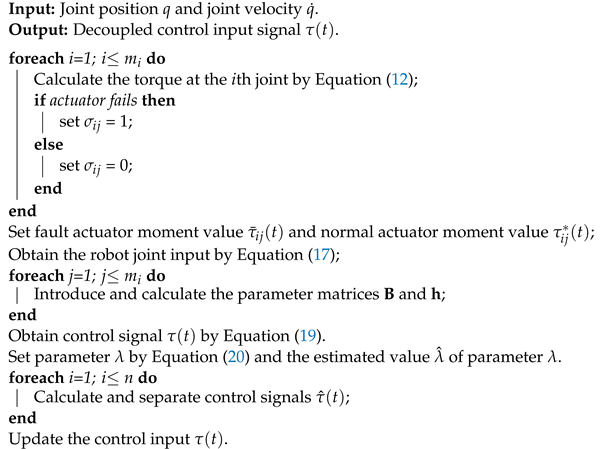 |
3.1. Dynamics of Manipulator with Unknown Actuator Failure
- Up to −1 actuators can experience instantaneous failure, and even in the absence of knowledge about the specific failure characteristics, the remaining actuators can dynamically adjust their actions to achieve the desired objective.
3.2. Fixed-Time Neural Network Controller and Stability Analysis
4. Simulation Study
4.1. Robot Kinematics
4.2. Simulation Setup
4.3. Simulation Results
5. Conclusions
Author Contributions
Funding
Institutional Review Board Statement
Informed Consent Statement
Data Availability Statement
Conflicts of Interest
References
- Dai, S.L.; Lu, K.; Jin, X. Fixed-Time Formation Control of Unicycle-Type Mobile Robots with Visibility and Performance Constraints. IEEE Trans. Ind. Electron. 2020, 68, 12615–12625. [Google Scholar] [CrossRef]
- Lu, K.; Liu, Z.; Lai, G.; Chen, C.L.P.; Zhang, Y. Adaptive Consensus Tracking Control of Uncertain Nonlinear Multiagent Systems With Predefined Accuracy. IEEE Trans. Cybern. 2021, 51, 405–415. [Google Scholar] [CrossRef]
- Li, W.; Song, C.; Li, Z. An Accelerated Recurrent Neural Network for Visual Servo Control of a Robotic Flexible Endoscope with Joint Limit Constraint. IEEE Trans. Ind. Electron. 2019, 67, 10787–10797. [Google Scholar] [CrossRef]
- Liu, Y.; Gong, M.; Liu, L.; Tong, S.; Chen, C. Fuzzy Observer Constraint Based on Adaptive Control for Uncertain Nonlinear MIMO Systems With Time-Varying State Constraints. IEEE Trans. Cybern. 2021, 51, 1380–1389. [Google Scholar] [CrossRef]
- Chen, J.; Hua, C. Adaptive Full-State-Constrained Control of Nonlinear Systems With Deferred Constraints Based on Nonbarrier Lyapunov Function Method. IEEE Trans. Cybern. 2020, 52, 7634–7642. [Google Scholar] [CrossRef]
- Sun, T.; Pei, H.; Pan, Y.; Zhou, H.; Zhang, C. Neural network-based sliding mode adaptive control for robot manipulators. Neurocomputing 2011, 74, 2377–2384. [Google Scholar] [CrossRef]
- Jiang, Y.; Wang, Y.; Miao, Z.; Na, J.; Zhao, Z.; Yang, C. Composite-Learning-Based Adaptive Neural Control for Dual-Arm Robots With Relative Motion. IEEE Trans. Neural Netw. Learn. Syst. 2022, 33, 1010–1021. [Google Scholar] [CrossRef] [PubMed]
- Zhang, S.; Dong, Y.; Ouyang, Y.; Yin, Z.; Peng, K. Adaptive Neural Control for Robotic Manipulators With Output Constraints and Uncertainties. IEEE Trans. Neural Netw. Learn. Syst. 2018, 29, 5554–5564. [Google Scholar] [CrossRef] [PubMed]
- Yang, C.; Huang, D.; He, W.; Cheng, L. Neural Control of Robot Manipulators With Trajectory Tracking Constraints and Input Saturation. IEEE Trans. Neural Netw. Learn. Syst. 2021, 32, 4231–4242. [Google Scholar] [CrossRef] [PubMed]
- Yang, C.; Peng, G.; Li, Y.; Cui, R.; Li, Z. Neural Networks Enhanced Adaptive Admittance Control of Optimized Robot-Environment Interaction. IEEE Trans. Cybern. 2018, 49, 2568–2579. [Google Scholar] [CrossRef]
- Zhang, F.; Huang, P. Fuzzy-based Adaptive Super-Twisting Sliding-Mode Control for a Maneuverable Tethered Space Net Robot. IEEE Trans. Fuzzy Syst. 2020, 29, 1739–1749. [Google Scholar] [CrossRef]
- Han, J.; Yang, S.; Xia, L.; Chen, Y.H. Deterministic Adaptive Robust Control With a Novel Optimal Gain Design Approach for a Fuzzy 2-DOF Lower Limb Exoskeleton Robot System. IEEE Trans. Fuzzy Syst. 2021, 29, 2373–2387. [Google Scholar] [CrossRef]
- Pan, Y.; Du, P.; Xue, H.; Lam, H.K. Singularity-Free Fixed-Time Fuzzy Control for Robotic Systems With User-Defined Performance. IEEE Trans. Fuzzy Syst. 2021, 29, 2388–2398. [Google Scholar] [CrossRef]
- Lewis, F.L.; Jagannathan, S.; Yesildirek, A. Neural Network Control of Robot Manipulators and Nonlinear Systems; CRC Press: Boca Raton, FL, USA, 1999. [Google Scholar]
- Qiu, J.; Wang, T.; Sun, K.; Rudas, I.J.; Gao, H. Disturbance Observer-Based Adaptive Fuzzy Control for Strict-Feedback Nonlinear Systems with Finite-Time Prescribed Performance. IEEE Trans. Fuzzy Syst. 2021, 30, 1175–1184. [Google Scholar] [CrossRef]
- Zhu, B.; Wang, Y.; Zhang, H.; Xie, X. Fuzzy Functional Observer-based Finite-Time Adaptive Sliding Mode Control for Nonlinear Systems with Matched Uncertainties. IEEE Trans. Fuzzy Syst. 2021, 30, 918–932. [Google Scholar] [CrossRef]
- Sui, S.; Xu, H.; Tong, S.; Chen, C.L.P. Prescribed Performance Fuzzy Adaptive Output Feedback Control for Nonlinear MIMO Systems in a Finite Time. IEEE Trans. Fuzzy Syst. 2022, 30, 3633–3644. [Google Scholar] [CrossRef]
- Zhu, C.; Jiang, Y.; Yang, C. Fixed-Time Neural Control of Robot Manipulator With Global Stability and Guaranteed Transient Performance. IEEE Trans. Ind. Electron. 2023, 70, 803–812. [Google Scholar] [CrossRef]
- Chakravarty, A.; Nizami, T.K.; Kar, I.; Mahanta, C. Adaptive Compensation of Actuator Failures using Multiple Models. IFAC-PapersOnLine 2017, 50, 10350–10356. [Google Scholar] [CrossRef]
- Liu, L.; Shi, K.; Yuan, X.; Li, Q. Multiple model-based fault-tolerant control system for distributed drive electric vehicle. J. Braz. Soc. Mech. Sci. Eng. 2019, 41, 531. [Google Scholar] [CrossRef]
- Amini, N.; Zhu, Q. Fault detection and diagnosis with a novel source-aware autoencoder and deep residual neural network. Neurocomputing 2022, 488, 618–633. [Google Scholar] [CrossRef]
- Zhong, Y.; Zhang, W.; Zhang, Y.; Zuo, J.; Zhan, H. Sensor Fault Detection and Diagnosis for an Unmanned Quadrotor Helicopter. J. Intell. Robot. Syst. 2019, 96, 555–572. [Google Scholar] [CrossRef]
- Samir, Z.; Hemza, M.; Abderrahmen, B.; Ali, D. Actuator fault tolerant control using adaptive RBFNN fuzzy sliding mode controller for coaxial octorotor UAV. ISA Trans. 2018, 80, S0019057818302234. [Google Scholar]
- Hu, Q.; Shao, X.; Guo, L. Adaptive Fault-Tolerant Attitude Tracking Control of Spacecraft With Prescribed Performance. IEEE/ASME Trans. Mechatron. 2018, 23, 331–341. [Google Scholar] [CrossRef]
- Mao, Z.; Yan, X.G.; Jiang, B.; Chen, M. Adaptive Fault-Tolerant Sliding-Mode Control for High-Speed Trains With Actuator Faults and Uncertainties. IEEE Trans. Intell. Transp. Syst. 2020, 21, 2449–2460. [Google Scholar] [CrossRef]
- Qi, H.; Shi, Y.; Li, S.; Tian, Y.; Yu, D.L.; Gomm, J.B. Fault tolerant control for nonlinear systems using sliding mode and adaptive neural network estimator. Soft Comput. 2020, 24, 11535–11544. [Google Scholar] [CrossRef]
- Liu, Y.J.; Zeng, Q.; Tong, S.; Chen, C.; Liu, L. Actuator Failure Compensation-Based Adaptive Control of Active Suspension Systems With Prescribed Performance. IEEE Trans. Ind. Electron. 2020, 67, 7044–7053. [Google Scholar] [CrossRef]
- Wang, J.; Liu, Z.; Chen, C.L.P.; Zhang, Y.; Lai, G. Extended dimension fuzzy adaptive control for nonlinear uncertain stochastic systems with actuator constraints. Nonlinear Dyn. 2019, 98, 1315–1329. [Google Scholar] [CrossRef]
- Ouyang, H.; Lin, Y. Adaptive Fault-Tolerant Control and Performance Recovery Against Actuator Failures With Deferred Actuator Replacement. IEEE Trans. Autom. Control 2021, 66, 3810–3817. [Google Scholar] [CrossRef]
- Tao, G.; Chen, S.; Joshi, S.M. An adaptive actuator failure compensation controller using output feedback. Autom. Control IEEE Trans. 2002, 47, 506–511. [Google Scholar] [CrossRef]
- Lai, G.; Wen, C.; Liu, Z.; Zhang, Y.; Chen, C.P.; Xie, S. Adaptive compensation for infinite number of actuator failures/faults using output feedback control. Inf. Sci. 2017, 399, 1–12. [Google Scholar] [CrossRef]
- Tang, X.; Tao, G. An adaptive nonlinear output feedback controller using dynamic bounding with an aircraft control application. Int. J. Adapt. Control Signal Process. 2009, 23, 609–639. [Google Scholar] [CrossRef]
- Tang, X.; Gang, T.; Joshi, S.M. Adaptive actuator failure compensation for parametric strict feedback systems and an aircraft application. Automatica 2003, 39, 1975–1982. [Google Scholar] [CrossRef]
- Wang, W.; Wen, C. Adaptive Actuator Failure Compensation Control of Uncertain Nonlinear Systems with Guaranteed Transient Performance; Automatica Oxford: Oxford, UK, 2010. [Google Scholar]
- Rugthum, T.; Tao, G. An adaptive actuator failure compensation scheme for a cooperative manipulator system. Robotica 2016, 34, 1529–1552. [Google Scholar] [CrossRef]
- Rugthum, T. Dynamic structure adaptive actuator failure compensation scheme for robotic systems. In Proceedings of the 2018 International Conference on Engineering, Applied Sciences, and Technology (ICEAST), Manado, Indonesia, 26–27 October 2018; pp. 1–4. [Google Scholar]
- Kececi, E.F.; Tang, X.; Gang, T. Adaptive actuator failure compensation for redundant manipulators. Robotica 2009, 27, 19–28. [Google Scholar] [CrossRef]
- Zhang, W.; Tan, M.; Hou, Z.; Cheng, L. Tracking Control of a Closed-Chain Five-Bar Robot with Two Degrees of Freedom by Integration of an Approximation-Based Approach and Mechanical Design. IEEE Trans. Syst. Man, Cybern. Part B Cybern. 2012, 42, 1470–1479. [Google Scholar]
- Huang, Y.; Jia, Y. Adaptive Fixed-Time Six-DOF Tracking Control for Noncooperative Spacecraft Fly-Around Mission. IEEE Trans. Control. Syst. Technol. 2018, 27, 1796–1804. [Google Scholar] [CrossRef]
- Zuo, Z. Nonsingular Fixed-Time Consensus Tracking for Second-Order Multi-Agent Networks; Pergamon Press, Inc.: Oxford, UK, 2015. [Google Scholar]
- Huang, J.T. Global Tracking Control of Strict-Feedback Systems Using Neural Networks. IEEE Trans. Neural Netw. Learn. Syst. 2012, 23, 1714–1725. [Google Scholar] [CrossRef]
- Zhang, L.; Wang, Y.; Hou, Y.; Li, H. Fixed-Time Sliding Mode Control for Uncertain Robot Manipulators. IEEE Access 2019, 7, 149750–149763. [Google Scholar] [CrossRef]
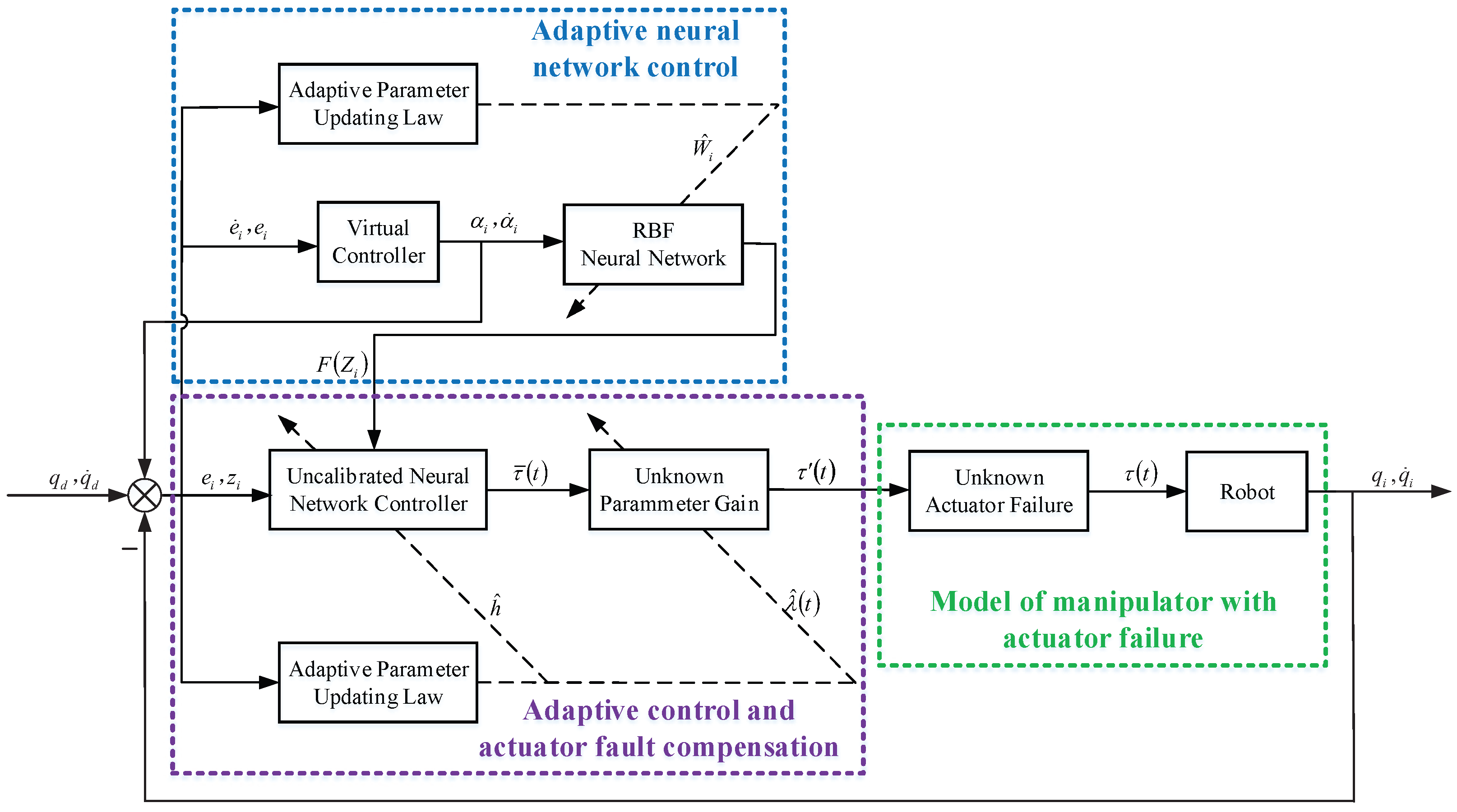
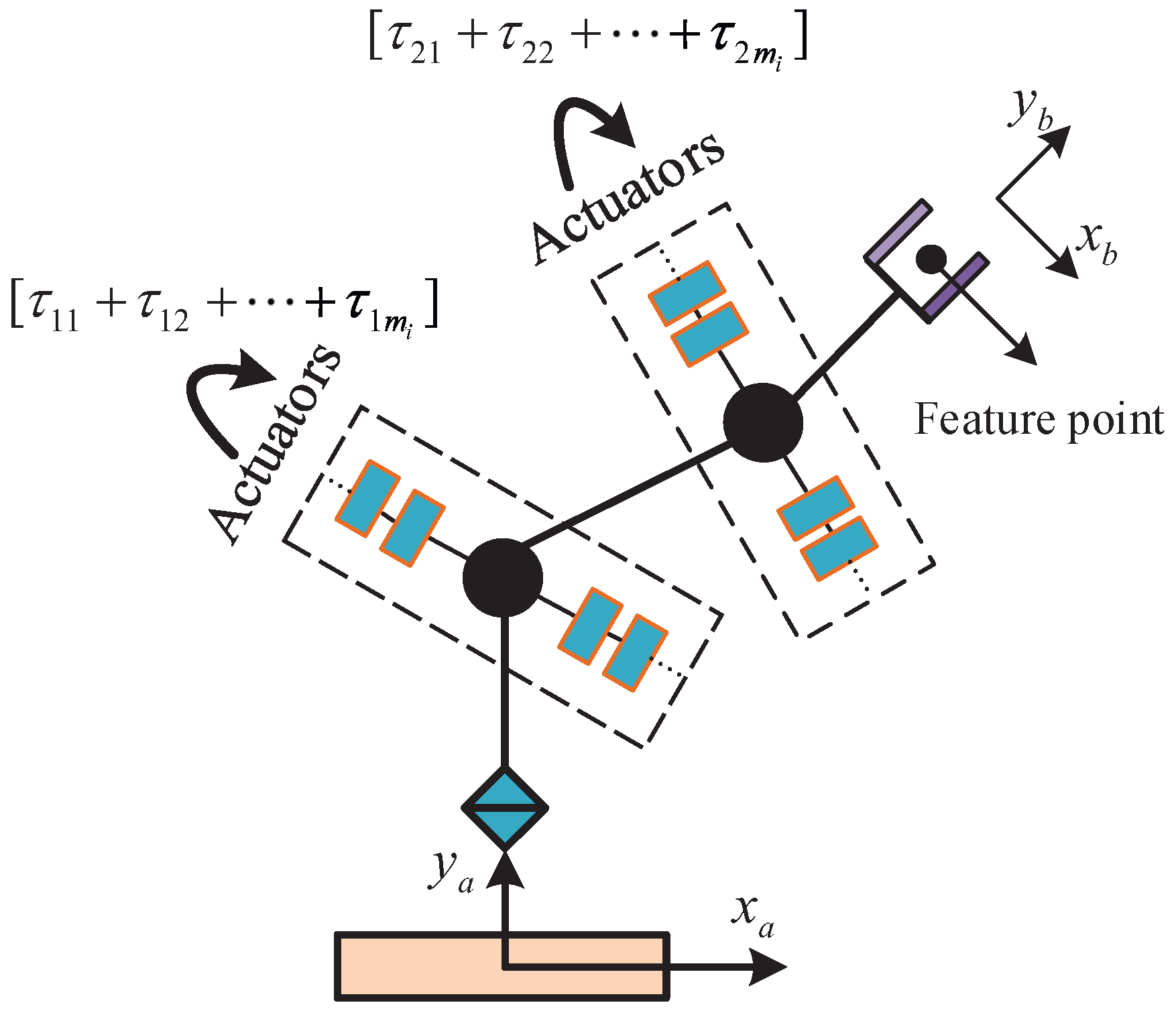
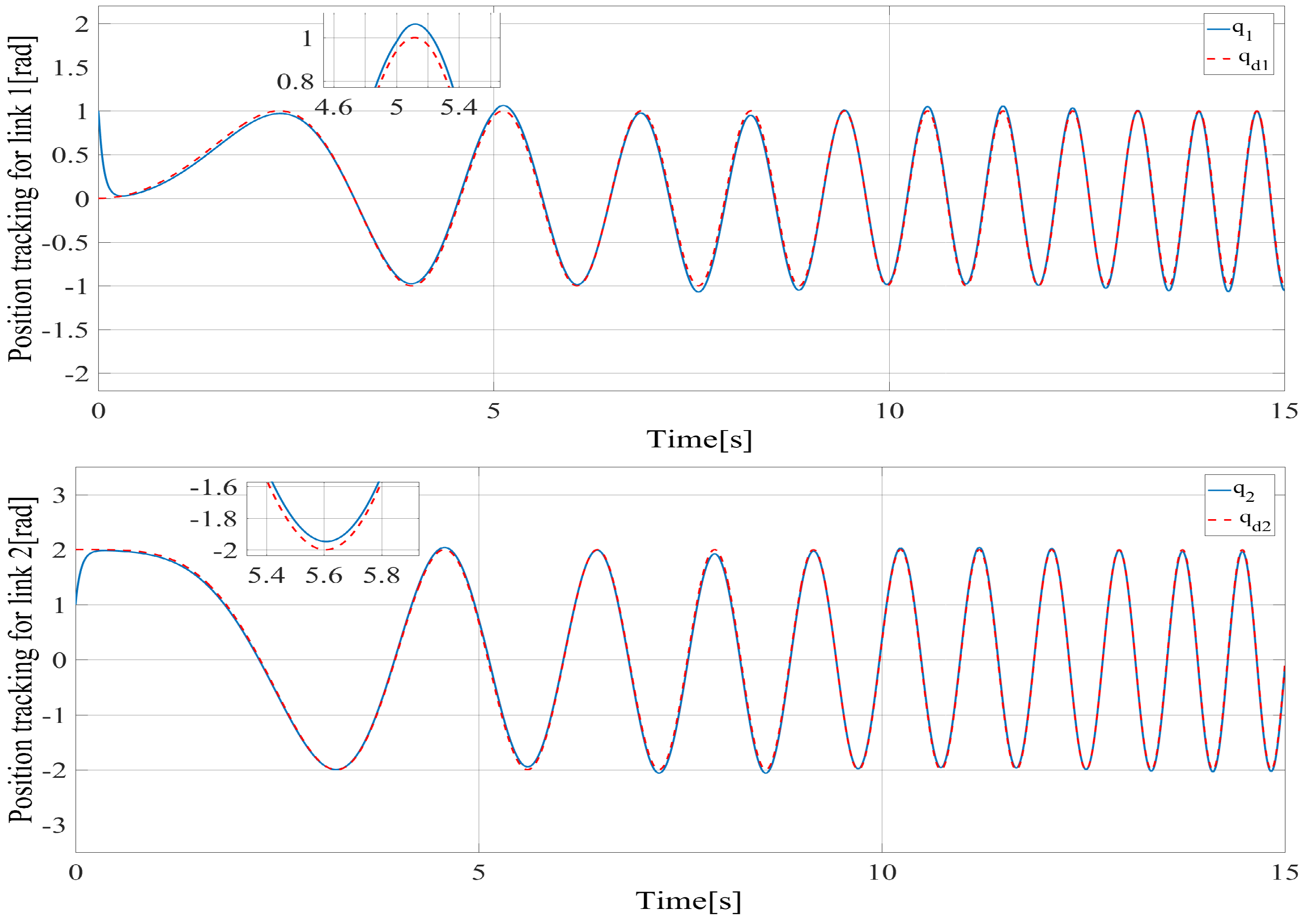
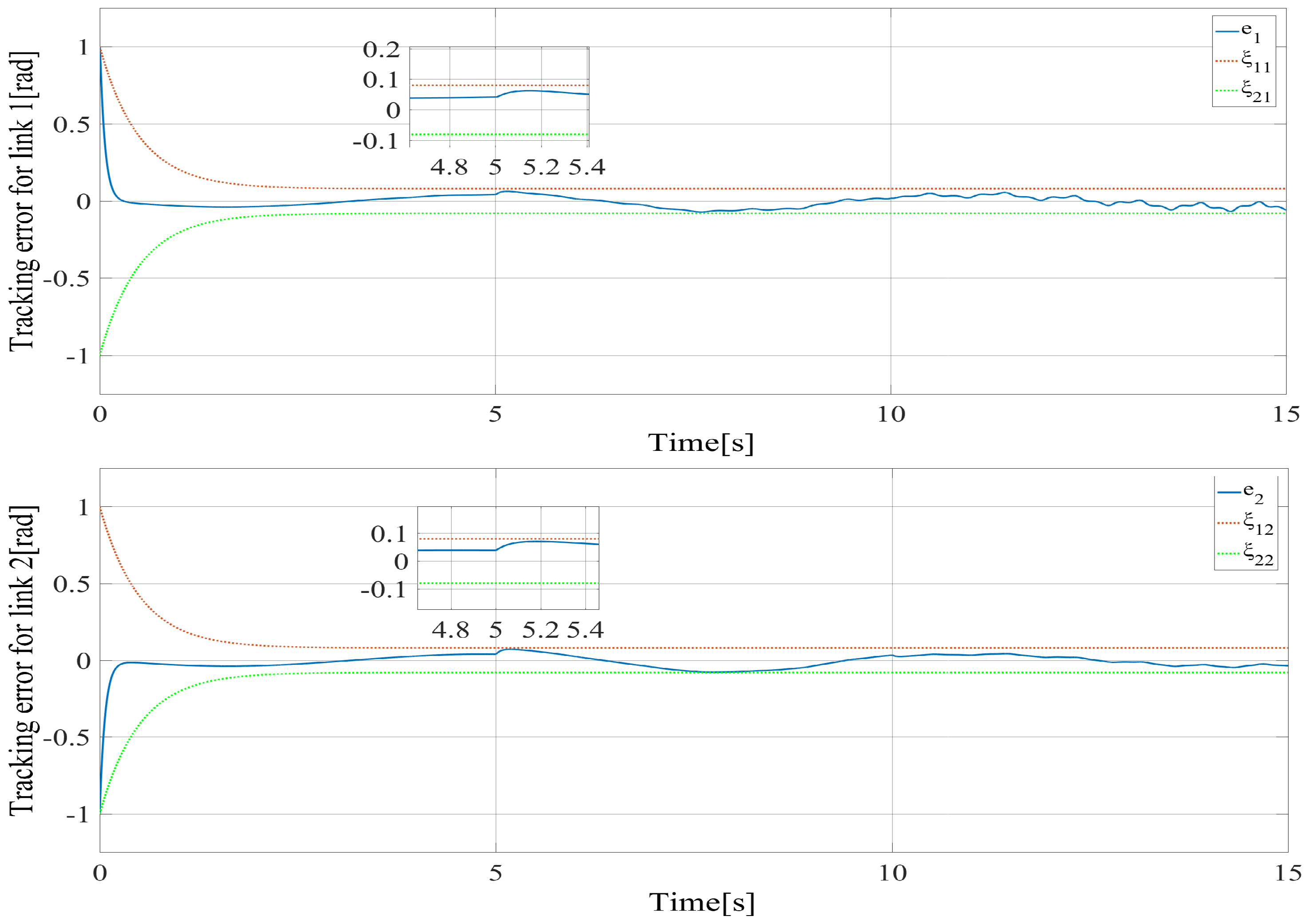
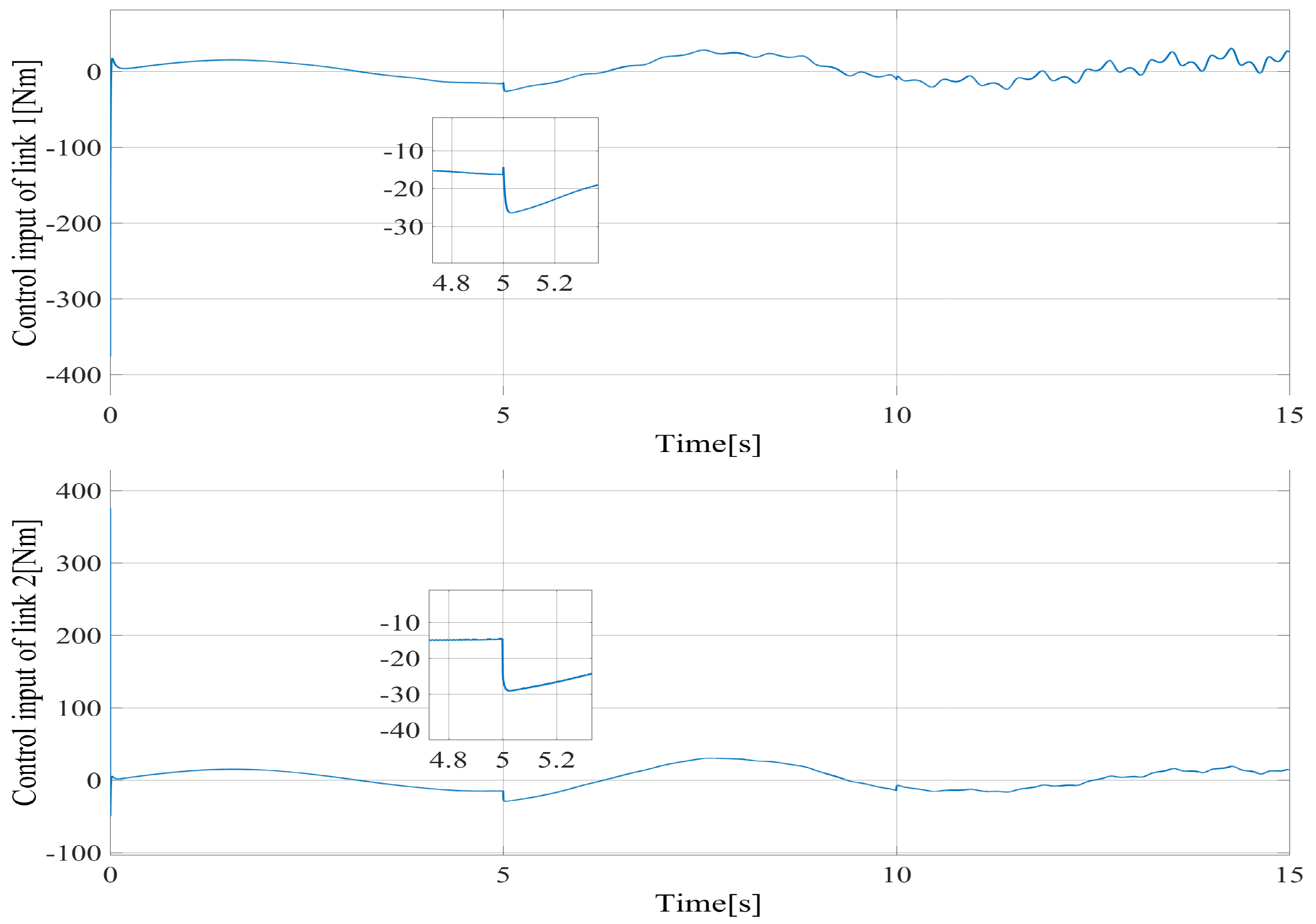


Disclaimer/Publisher’s Note: The statements, opinions and data contained in all publications are solely those of the individual author(s) and contributor(s) and not of MDPI and/or the editor(s). MDPI and/or the editor(s) disclaim responsibility for any injury to people or property resulting from any ideas, methods, instructions or products referred to in the content. |
© 2023 by the authors. Licensee MDPI, Basel, Switzerland. This article is an open access article distributed under the terms and conditions of the Creative Commons Attribution (CC BY) license (https://creativecommons.org/licenses/by/4.0/).
Share and Cite
Lai, G.; Zhou, S.; Yang, W.; Wang, X.; Wang, F. Prescribed Fixed-Time Adaptive Neural Control for Manipulators with Uncertain Dynamics and Actuator Failures. Mathematics 2023, 11, 2925. https://doi.org/10.3390/math11132925
Lai G, Zhou S, Yang W, Wang X, Wang F. Prescribed Fixed-Time Adaptive Neural Control for Manipulators with Uncertain Dynamics and Actuator Failures. Mathematics. 2023; 11(13):2925. https://doi.org/10.3390/math11132925
Chicago/Turabian StyleLai, Guanyu, Sheng Zhou, Weijun Yang, Xiaodong Wang, and Fang Wang. 2023. "Prescribed Fixed-Time Adaptive Neural Control for Manipulators with Uncertain Dynamics and Actuator Failures" Mathematics 11, no. 13: 2925. https://doi.org/10.3390/math11132925
APA StyleLai, G., Zhou, S., Yang, W., Wang, X., & Wang, F. (2023). Prescribed Fixed-Time Adaptive Neural Control for Manipulators with Uncertain Dynamics and Actuator Failures. Mathematics, 11(13), 2925. https://doi.org/10.3390/math11132925






